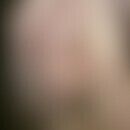Synonym(s)
DefinitionThis section has been translated automatically.
Acute bacterial infection of the skin and perichondrium of the auricle (usually Pseudomonas aeruginosa). Auricular perichondritis is the most common perichondritis. But acute bacterial perichondritis can also occur in the larynx or nose.
PathogenThis section has been translated automatically.
Pseudomonas aeruginosa (in a larger study detection in 69% of patients - Davidi E et al. 2011), more rarely Staphylococcus aureus are the trigger of infection.
You might also be interested in
EtiopathogenesisThis section has been translated automatically.
Perichondritis can be caused by trivial injuries - including blunt trauma, burns, insect bites, piercings through the cartilage(post piercing perichondritis - Fernandez AP et al. 2008), a surgical procedure or by folliculitis of the ear. The infection also tends to occur in people with inflammatory diseases such as granulomatosis with polyangiitis (syn.: Wegener's granulomatosis) with a weakened immune system or diabetes.
ManifestationThis section has been translated automatically.
Mostly younger patients aged between 16 and 35 years (Prasad HK et al. 2007)
ClinicThis section has been translated automatically.
Painful redness and swelling of the auricle. Hot, protruding auricle. The relief of the auricle is no longer recognizable. Possibly mild to moderate fever. Regional lymphadenopathy. If left untreated, pus accumulates between the cartilage and the perichondrium. This creates the risk of focal necrosis of the ear cartilage and deformation of the pinna (Thill MP et al. 2016). The recess of the earlobe is typical.
DiagnosisThis section has been translated automatically.
Clinical findings. Pap smear.
Differential diagnosisThis section has been translated automatically.
In this context, a general clarification of the so-called "red ear syndrome" applies.
Perichondritis in the context of an inflammatory rheumatic systemic disease with preferential attack of the articular and non-articular cartilage with chondrolysis, dystrophy and atrophy. Leading symptoms are auricular chondritis and nasal chondritis as well as arthralgias and arthritides (in 1/3 of the patients as initial symptoms). Furthermore, there is a possible infestation of the hyaline articular cartilage as well as the fibrocartilage of intervertebral discs.
Acute contact dermatitis: Itching dermatitis limited to the contact area. No fluctuation; no pain.
Tuberculosis cutis luposa: chronic non-painful dermatitis
Lymphocytoma: chonic non-painful soft nodulation
Acrodermatitis chronica atrophicans: chronic non painful dermatitis
Erysipelas: Highly acute, febrile, painful, non fluctuating dermatitis. Earlobes involved.
Boils: circumscribed abscess, initially no spreading to the perichondrium.
External therapyThis section has been translated automatically.
Moist envelopes with antiseptic additives such as potassium permanganate (light pink) or quinolinol (e.g. quinosol 1:1000 or R042 ). If antibiotic therapy is not or not sufficiently effective, early surgical repair with removal of all necrotic material.
In case of post piercing chondritis the immediate removal of the piercing pin is absolutely necessary.
Internal therapyThis section has been translated automatically.
Initial antibiosis with penicillase-resistant penicillins such as Dicloxacillin (e.g. InfectoStaph), 2-4 g/day p.o. in 4 ED.
Alternatively or if gram-negative pathogens are suspected: cephalosporins or ciprofloxacin (e.g. Ciprobay) 250-750 mg/day p.o.
Note(s)This section has been translated automatically.
The earlobe is usually left out during the painful inflammatory process. This is an important differential diagnostic indication to distinguish it from the erysipelas of the auricle. In most cases this involves the earlobe.
LiteratureThis section has been translated automatically.
- Davidi E et al (2011) Perichondritis of the auricle: analysis of 114 cases. Isr Med Assoc J 13:21-24.
- Eismann R et al (2011) Red ear syndrome: case report and review of the literature. Dermatology 223:196-199.
- Fernandez AP et al (2008) Post-piercing perichondritis. Braz J Otorhinolaryngol 74:933-937.
- Giles WC et al (2007) Incision and drainage followed by mattress suture repair of auricular hematoma. Laryngoscope 117: 2097-2099.
- Kaplan AL et al (2004) The incidences of chondritis and perichondritis associated with the surgical manipulation of auricular cartilage.Dermatol Surgery 30:58-62
- Pena FM et al (2006) Auricular perichondritis by piercing complicated with pseudomonas infection. Braz J Otorhinolaryngol 72:717.
- Prasad HK et al (2007) Perichondritis of the auricle and its management. J Laryngol Otol 121:530-534.
- Thill MP et al (2016) Acute external ear lesions: clinical aspects, assessment and management. B-ENT Suppl 26:155-171.
Incoming links (4)
Borrelia lymphocytoma; Otitis; Post piercing chondritis; Quinolinol sulphate monohydrate solution 0,1 % (nrf 11.127.);Outgoing links (13)
Acrodermatitis chronica atrophicans; Boils; Borrelia lymphocytoma; Cephalosporins; Ciprofloxacin; Contact dermatitis (overview); Dicloxacillin; Erysipelas; Post piercing chondritis; Potassium permanganate; ... Show allDisclaimer
Please ask your physician for a reliable diagnosis. This website is only meant as a reference.





